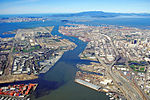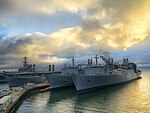Alameda Point, Alameda, California
Alameda Point is the name given to the lands of the former Naval Air Station Alameda in the City of Alameda, California. Alameda Point consists of 1,560 acres (6.3 km2) of land area at the western end of the island of Alameda. Most of the land was reclaimed from the San Francisco Bay. NAS Alameda was identified for closure under the Base Realignment and Closure (BRAC) Program in 1993, and ceased operation in April 1997. An agreement between the Navy and the City of Alameda for transferring the land to the City for future development was reached in 2006. One of the larger issues between the Navy and the City has been paying the costs of the environmental cleanup required. Prior to the transfer, some of the facilities of the former base have been leased to private tenants and the City of Alameda. The Alameda Point beach is one of the cleanest in the state. Alameda Point has a number of film sites. Beginning in late 2006 the Mythbusters began to test various experiments on the former runway while in 2009, NBC's Trauma staged a plane crash.
Excerpt from the Wikipedia article Alameda Point, Alameda, California (License: CC BY-SA 3.0, Authors).Alameda Point, Alameda, California
Airfield Perimeter Road,
Geographical coordinates (GPS) Address Nearby Places Show on map
Geographical coordinates (GPS)
| Latitude | Longitude |
|---|---|
| N 37.785775 ° | E -122.31843 ° |
Address
NAS Alameda (abandoned)
Airfield Perimeter Road
94110
California, United States
Open on Google Maps









